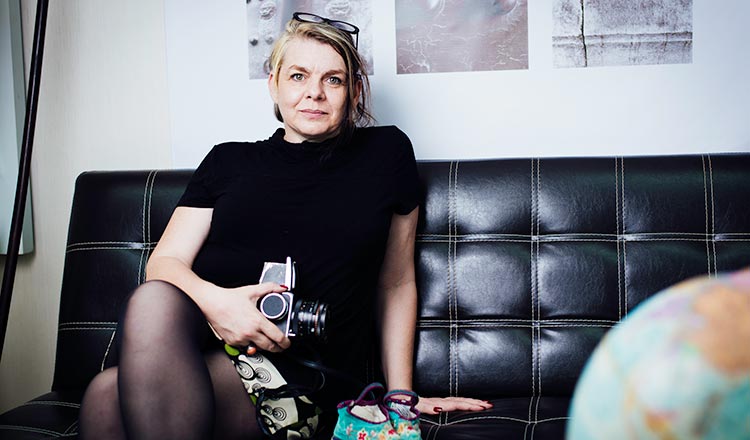MEDIA: Telling stories that nobody wanted to Know at all
UK-born Jo Farrell started travelling to China in 2005 to search for the last remaining women with bound feet. She tells Anith Adilah Othman stories of the suffering these women had to endure in a practice that had been considered a norm for centuries.
.
Jo Farrell is not your average storyteller. Her weapon of choice is a medium-format film camera. Her subjects, uniquely, are often things hushed by the modern-day society for they are deemed ‘backward’ or ‘barbaric’. But with a strong background in cultural anthropology, she cannot help but to dig into the untold tales of the world, tales that unfortunately will fade and wither as time passes by.
Farrell’s works typically revolve around women and their various methods of channelling beauty according to their respective tradition and culture – regardless of how unconventional they might be. These, of course, included China’s footbinding women, Myanmar’s tattooed Chin women and the long-necked Kayan women.
Filled with curiosity, the British-born started travelling to China in 2005 to possibly search for the last remaining women with bound feet. She has heard about them; she knew they lived somewhere in the vast lands of the Orient but she was unsure if she could actually meet them in the flesh.
.
ADS by Cloud 9:
.
– SPACE RESERVE FOR YOUR ADVERTISEMENT –
.
.

.
After a handful of futile attempts which was starting to get a little frustrating, a conversation in a cab in Shanghai completely changed the course of Farrell’s life.
“Our driver said he couldn’t help but overhear us talking. He just blurted that his grandmother happened to have bound feet and I was like, ‘Oh my God, we have to meet her’,” she told Good Times2.
Farrell then travelled to the Shandong province, where she met her first subject for the first time ever in 2006 – Zhang Yun Ying – who has had her feet bound when she was at the tender age of seven and unbound them in her 20s. Farrell had been visiting Zhang every year since they met until the latter’s demise last year. She was 91.
“I still remember the first time I saw Zhang removing her shoes and I held her feet in my hands…they were so soft. They actually looked like a little sculpture, I thought it was quite beautiful actually,” she said, adding that they are sometimes called ‘lotus feet’ for the way the shape resembles the flower.
“In that moment I realised how much suffering she had to go through to achieve this. There wasn’t like a guidebook, you know, like ‘how to bind your daughter’s feet’. They just knew that they need to get the feet smaller, somehow.”
Over the next few years, Farrell continued to travel across China and met 50 women, between 70 to 90 at that time, who had devoted their life to the practice – some by force, while some victims of peer pressure. Their stories and photographs are now immortalised in a book called Living History: Bound Feet Women of China.
“The women I spoke to were more than happy to have their pictures taken. Most of them were friendly and accommodating. Surprisingly, it was the younger ones that were more apprehensive about my project. They did not want the masses to think of China as a backward nation for having this kind of practice,” she said.
Farrell said although footbinding is considered fairly barbaric, it was a tradition that could guarantee better opportunities. It enabled women to find a suitable partner. It also meant that the girls from rural areas could marry into a family with more land or more sheep.
.
ADS by Cloud 9:
.
– SPACE RESERVE FOR YOUR ADVERTISEMENT –
.
.

.
“They bound their feet to make sure that they have a better life, so that they could actually find a husband. And for them who were living in poor communities, it was completely important to achieve this.”
While she acknowledged that the practice would have been heavily criticised if it had still taken place in today’s world, she said it was still something that has been considered a norm for centuries. “We should not be judgmental,” she quipped.
“In every society and culture, there are different things that we are taught to do to make ourselves more attractive, more attainable, or basically to make us feel like we belong to a group.
In Farrell’s own words, this was how the women used to bind their feet: “The small toes would be wrapped under the foot, leaving the big toe forward, and long cotton bindings, like bandages, were stretched round the heel of the foot. Over a period of time the small bones in the toes would break beneath their weight and the arch would lift so that the heel would almost touch the metatarsals, creating a cavern.”
“When I get reactions like ‘Oh, that is horrible, how could they do something like that?’ I asked if they themselves pluck their eyebrows or wax their legs and for what reason. There are a lot more rules and expectations about how a woman should look and act like in every culture,” she said.
“People have so much judgment…lacking the cultural understanding that we are all different. We don’t all want to be similar.”
Her works have been published by a multitude of news agencies such as the BBC, CNN, and South China Morning Post. Even so, Farrell is showing no sign of slowing down. When met, she was in the midst of documenting the Kayan women and the Chin women in Myanmar – both notoriously famed for their culture of donning brass coils and having facial tattoos respectively. These were projects that she has been working on for the past three years.
“It is very interesting. I met a girl who was 16 when she was married off. After that she was sent to Chiangmai, Thailand to had her coils put on. She then had to work and stay there for a year to make money for her in-laws.
“I also met four Kayan women who have had their coils removed, because they are poor so they needed to sell them for money. I will be focusing on them for one specific project,” she said.
.
ADS by Cloud 9:
.
– SPACE RESERVE FOR YOUR ADVERTISEMENT –
.
.

.
As we sat on the 16th floor at one of the city’s very few skyscrapers – the Rosewood Phnom Penh – Farrell occasionally would stare out the huge glass window pane and her sight would fall on the bustling city below. This was her first time back here in 8 years.
It didn’t take long before a smile formed in the corner of her mouth. “My father designed this building, you know,” she blurted, with enough glimmer in her eyes to say how proud she is to be her father’s daughter.
It has been a long time coming. The last time she was here, which the Vattanac Capital Tower was a mere vision of Sir Terry Farrell, her father and also the founder of award-winning Farrells Architects.
Farrell made a quick stop in Phnom Penh before her latest exhibition in Cambodia last month at Ammo Jewellery in Siam Reap, where her works on the bound women were featured during the Angkor Photo Festival.
Watching her watch other people as we chatted, it is quite obvious that Farrell naturally soaks up her surroundings, collecting mental images of the people she rubs shoulders with, but never without a smile. She has more stories to be told, she promised Good Times2, and we truly cannot wait.
.
ADS by Cloud 9:
.
– SPACE RESERVE FOR YOUR ADVERTISEMENT –
.
.
.







 All photographs, news, editorials, opinions, information, data, others have been taken from the Internet ..aseanews.net |
All photographs, news, editorials, opinions, information, data, others have been taken from the Internet ..aseanews.net | 






